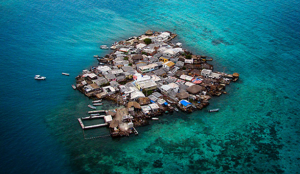Throughout history, islands have been ideal places for people to settle, since they’re easy to defend and their proximity to water makes them ideal for commerce. Paris, New York City, St. Petersburg, Hong Kong and Macau, among others, are all cities that are built upon islands. Therefore, you’d probably think that somewhere like Manhattan would be the most densely-populated island in the world. But what if I were to tell you that title didn’t belong to some part of a major world city, but rather in a remote part of the Caribbean off the coast of Colombia? I recently came across an article about Santa Cruz del Islote, a tiny island where over 1,200 people live in an area that’s just over one-tenth of a square kilometre.
According to local legend, the island was discovered by accident some 150 years ago. Men from the coastal town of Barú stumbled upon it by accident while looking for new waters to fish, and decided to set up camp because it had no mosquitoes, unlike the other nine islands that surrounded it. The first night they slept there, the men had such pleasant dreams that they decided to stay. Nowadays, this tiny speck in the Caribbean is made up of just 90 houses, two shops, one restaurant and a school. Packed to the gills, these buildings back up right to the shoreline. There are no doctors or steady water supply, and only one generator that runs for no more than five hours a day. There’s no room for a cemetery, so the dead are buried on a neighboring island.
While such tight quarters might sound like a hellish nightmare, the locals of Santa Cruz del Islote would never dream of leaving, calling life here “calm and delightful”. Since everybody knows each other, there’s no need for police, and there isn’t any violence. There’s only one security guard on the island, since Colombian law requires that all schools have a security guard. Yet according to the security guard and the teacher, there’s hardly any need for one. The teacher, who has previously worked in schools on the mainland, says that the children here are much more docile, since in a small community where everybody knows everybody you learn to “respect your elders”.
For industry, the islanders depend on a steady flow of tourists, who travel 90 minutes on daily tour boats from the mainland to Santa Cruz del Islote and neighboring islands in the archipelago. Many sail to the adjacent island of Múcura to work in its high-end resort or offer fishing, snorkelling or diving excursions. Others fish and sell their shares to restaurants and suppliers on the mainland.
